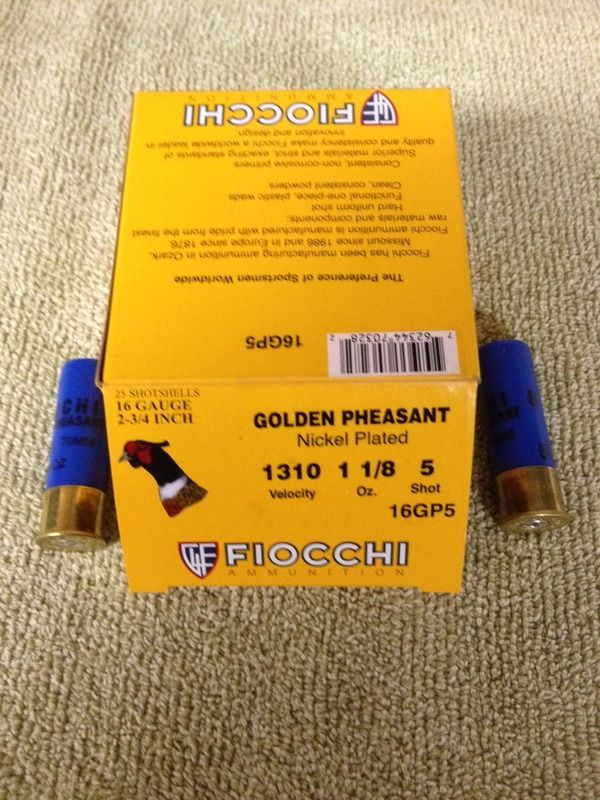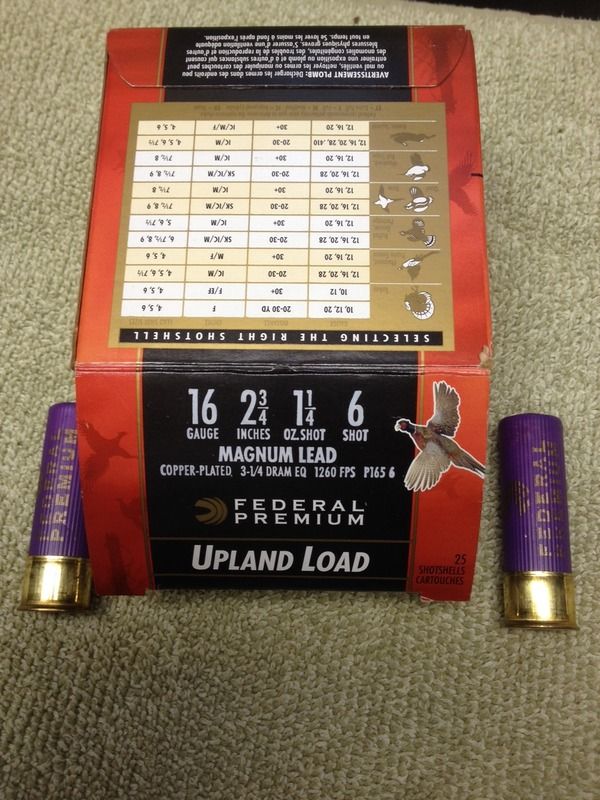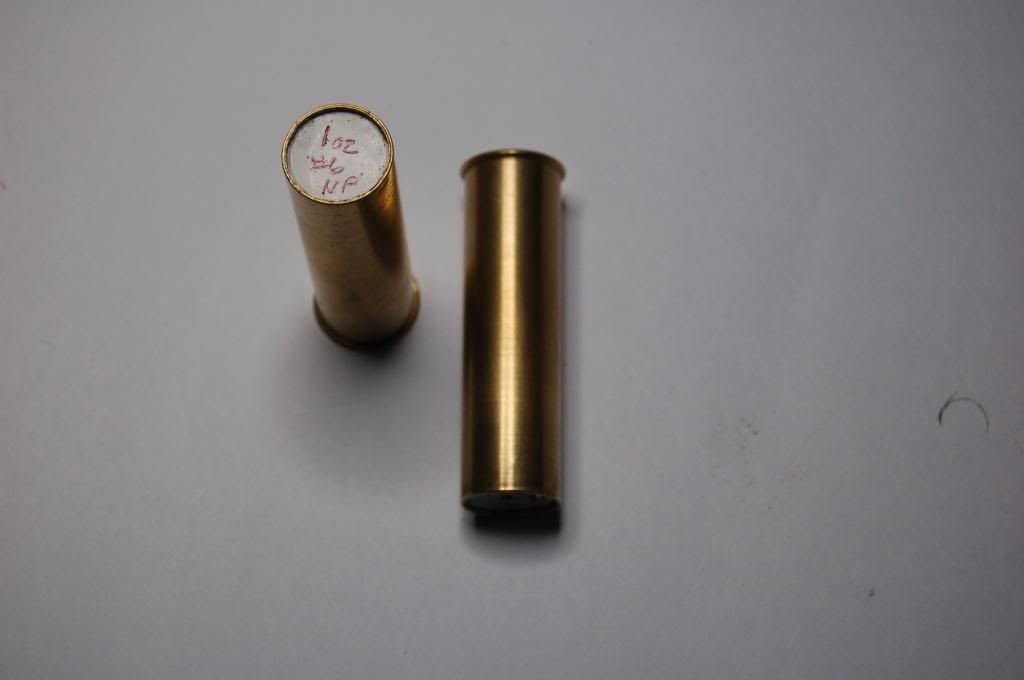I'm sure this has been discussed before but not since I've been a member. Shooting doves with a Franchi 48 20ga. Went through 2 boxes of Federals this morning with clays. 20ga 2 3/4 inches 7/8 oz shot 7 1/2 shot high brass game load. Winchester target shells same numbers on box- low brass. Just practicing with new to me shotgun. I was using high brass and someone suggested low brass because of recoil. I didn't see much recoil out of the shells I was using but I bought some low brass shells just to see if any difference in recoil. I couldn't see much recoil difference on high vs low. Your thoughts appreciated. Pembroke

Pembroke
high brass vs low brass
1 reading
Pembroke
Discussion starter
35 posts
·
Joined 2014
- Add to quote Only show this user
I'm sure this has been discussed before but not since I've been a member. Shooting doves with a Franchi 48 20ga. Went through 2 boxes of Federals this morning with clays. 20ga 2 3/4 inches 7/8 oz shot 7 1/2 shot high brass game load. Winchester target shells same numbers on box- low brass. Just practicing with new to me shotgun. I was using high brass and someone suggested low brass because of recoil. I didn't see much recoil out of the shells I was using but I bought some low brass shells just to see if any difference in recoil. I couldn't see much recoil difference on high vs low. Your thoughts appreciated. Pembroke
1,375 posts
·
Joined 2015
http://www.nssfblog.com/firstshotsnews/ ... ictionary/
The High Brass vs. Low Brass Myth
If you're a new shotgun hunter, one of the things you'll notice in retail stores are boxes of shotshell ammunition marked "high brass." This high brass, the portion of the shotshell that houses the primer and holds the plastic hull, is the source of some old wive's tales that just won't go away. Let me explain.
When I was a younger man, I was taught that the difference in the height of the brass rim was indicative of the power or velocity of the shotgun load. The longer the brass, the hotter the shell and the faster the shot traveled after it left the muzzle. High brass was more powerful than low brass. That may have once been true, but not anymore. When purchasing shotgun ammunition, ignore the length of the brass rim and pay attention to the labeled velocity and payload of shot (again, stated in ounces) of the shell.
11,042 posts
·
Joined 2005
High brass is only an advertising ploy to supposedly indicate "more power to the shell and more shot".
Just read box for the contents and velocity of the shell. You will be better informed of what you are shooting.
The high brass is unnecesary with today's powders and hulls.
Just read box for the contents and velocity of the shell. You will be better informed of what you are shooting.
The high brass is unnecesary with today's powders and hulls.
2,538 posts
·
Joined 2004
The above is correct, the kind of powder and the amount of powder and shot are what determines the power of the shell. Brass height means nothing.
4,920 posts
·
Joined 2006
FYI, all Federal 20 gauge hulls have high brass regardless of the load that's actually inside. It could be be a heavy field load or a lighter target load, you must read the box for the specs.Pembroke said:I'm sure this has been discussed before but not since I've been a member. Shooting doves with a Franchi 48 20ga. Went through 2 boxes of Federals this morning with clays. 20ga 2 3/4 inches 7/8 oz shot 7 1/2 shot high brass game load. Winchester target shells same numbers on box- low brass. Just practicing with new to me shotgun. I was using high brass and someone suggested low brass because of recoil. I didn't see much recoil out of the shells I was using but I bought some low brass shells just to see if any difference in recoil. I couldn't see much recoil difference on high vs low. Your thoughts appreciated. Pembroke
When you hear someone tell you to use "low brass shells for less recoil" you will know they are among the least informed shotgunners, and everything else they might say is also some thing they have heard repeated too many times, that may not be so.
11,042 posts
·
Joined 2005
That's akin to the old saying, "Use light target loads in old guns to go easy on them", yet most common light target loads are generally loaded by the factories with fast burning powders and have chamber pressures about as high as heavy hunting loads.
4,626 posts
·
Joined 2005
That's a bit of an over simplification, Bob. You're right about the pressure, but pressure isn't what is the problem. What potentially could damage older shotguns is excessive recoil. And recoil is a product of muzzle velocity and payload. In some respects, the Brits had it right when they proofed their shotguns by the maximum charge they could fire. The problem was that they were the only ones who understood this, and so they eventually fell into step with everyone else and proofed by chamber pressure. Bit mistake, in my opinion, as pressure only covers the chamber/barrels. Excessive recoil is cumulative for a gun just as it is for the shooter.BobK said:That's akin to the old saying, "Use light target loads in old guns to go easy on them", yet most common light target loads are generally loaded by the factories with fast burning powders and have chamber pressures about as high as heavy hunting loads.
Frank
426 posts
·
Joined 2007
Worn out any guns lately? I'll bet not. In fact, I agree with BobK, as far as presures go.Frank Lopez said:That's a bit of an over simplification, Bob. You're right about the pressure, but pressure isn't what is the problem. What potentially could damage older shotguns is excessive recoil. And recoil is a product of muzzle velocity and payload. In some respects, the Brits had it right when they proofed their shotguns by the maximum charge they could fire. The problem was that they were the only ones who understood this, and so they eventually fell into step with everyone else and proofed by chamber pressure. Bit mistake, in my opinion, as pressure only covers the chamber/barrels. Excessive recoil is cumulative for a gun just as it is for the shooter.BobK said:That's akin to the old saying, "Use light target loads in old guns to go easy on them", yet most common light target loads are generally loaded by the factories with fast burning powders and have chamber pressures about as high as heavy hunting loads.
Frank
But in the end, 99.99 percent of people, will not ever shoot a gun anywhere near wearing it to the point of needing a rebuild. So in that, shoot whatever you want.
4,626 posts
·
Joined 2005
That's a bet you'd have lost. I had a nice little V. Sarasqueta box lock in 20ga. Now, 20ga is supposed to be a 7/8oz gun, one ounce max. But back when I was young and dumb, I fell in with the bigger is better crowd and began shooting 3 inch loads out of her. It wasn't too long before that gun loosened up and needed a rebuild. There are many guns that are fine with target loads and even standard loads. But you start feeding it a fairly steady diet of magnums and you will shoot the gun out to the point of rebuilding. That's especially true of some of the European and Turkish guns now on the market. The 1100 is also prone to wear with heavy loads. I've seen a split aluminum receiver on a Mossberg from shooting slugs.H & H Rods said:Worn out any guns lately? I'll bet not. In fact, I agree with BobK, as far as presures go.
But in the end, 99.99 percent of people, will not ever shoot a gun anywhere near wearing it to the point of needing a rebuild. So in that, shoot whatever you want.
Frank
2,667 posts
·
Joined 2007
Hey aren't those made to take anything the ammunition company's load???
You guy's that have the macho kick keep shooting those 3 1/2 and 3 inch magnums.
As for me I'll stick with 12 gauge 1oz. minus and 20 gauge 3/4 oz. loadings. They are fun to shoot and still break the clays.
You guy's that have the macho kick keep shooting those 3 1/2 and 3 inch magnums.
As for me I'll stick with 12 gauge 1oz. minus and 20 gauge 3/4 oz. loadings. They are fun to shoot and still break the clays.
2,774 posts
·
Joined 2015
They'll kill doves just fine too. The people shooting Saturday morning trap league where I shoot get a kick out of all the hunters showing up to warm up for bird season on the skeet fields, invariably shooting really loud "heavy dove loads", as if doves were armor plated.jaguarxk120 said:You guy's that have the macho kick keep shooting those 3 1/2 and 3 inch magnums.
As for me I'll stick with 12 gauge 1oz. minus and 20 gauge 3/4 oz. loadings. They are fun to shoot and still break the clays.
148 posts
·
Joined 2012
Some of the responses raised a potential question about failure to feed in auto loaders. I have a Weatherby SA 08 20 gauge that won't feed Winchester super target 1210 fps while it will feed Fiocchis and Estates of the same velocity and load. Is it possible there is faster burning powder in non super targets or some other attribute? All shells mentioned are cheap target loads and non are high brass.
I did buy some high brass he t loads to break it in and they worked fine. Believe they were Remington's. Nice, but more expensive vs the above mentioned on a volume basis.
I did buy some high brass he t loads to break it in and they worked fine. Believe they were Remington's. Nice, but more expensive vs the above mentioned on a volume basis.
3,762 posts
·
Joined 2010
.
JMO, but ammo companies loved to save $$$$ - and don't forget that most of the basic shotshell load technology is over 100 years old.
High-base (smaller powder chamber) and low-base (larger powder chamber) were both used.
"Low" brass shells were $$ savers (think $0.01 savings per shell, over millions of shells made), because less brass height was needed to support the lighter loads using high-base cases.
When heavier loads were manufactured, the brass was extended to "high" brass, to better support the loads using low-base (more room for more powder) cases.
Maker's thinking & manufacturing methods have changed over the past 100-odd years.
.
JMO, but ammo companies loved to save $$$$ - and don't forget that most of the basic shotshell load technology is over 100 years old.
High-base (smaller powder chamber) and low-base (larger powder chamber) were both used.
"Low" brass shells were $$ savers (think $0.01 savings per shell, over millions of shells made), because less brass height was needed to support the lighter loads using high-base cases.
When heavier loads were manufactured, the brass was extended to "high" brass, to better support the loads using low-base (more room for more powder) cases.
Maker's thinking & manufacturing methods have changed over the past 100-odd years.
.
12,238 posts
·
Joined 2007
The highest brass shells bar none I'm aware of on the market right now (Rio Elite) are standard to light target loads.
3,231 posts
·
Joined 2014
I just think a "high brass" shell looks better, I always have and used them regardless of what game I was shooting when I was younger. It's the reason I like Rio target loads, they have higher "brass", yeah, it's now brass washed steel, than most target loads and I find them better looking.
The short, stubby steel or brass heads just don't look right to me.
I like the "brass" on these shells:


The short, stubby steel or brass heads just don't look right to me.
I like the "brass" on these shells:


2,667 posts
·
Joined 2007
Very heavy loadings for a 16 gauge gun. The proper load is one (1) ounce not 1 1/8 or 1 1/4 ounce.
Those loadings are actually for 12 gauge (1 1/8) and 10 gauge (1 1/4).
Shoot what is right for the gun and you will get better patterns.
Those loadings are actually for 12 gauge (1 1/8) and 10 gauge (1 1/4).
Shoot what is right for the gun and you will get better patterns.
4,514 posts
·
Joined 2011
As for the brass, the difference between the two is the height of the brass.....
12,238 posts
·
Joined 2007

The ONLY shell I've ever seen with taller brass was a CIL paper hunting load from the 50s or 60s that went quite nearly half way up the shell. Only marking is the shot size, #2s.
9,028 posts
·
Joined 2011
The 1 1/4-16 load in 4s or 5s is just fine in a Sweet 16 when the wind blows and the snow slants across the prairie on it's way to who knows where.jaguarxk120 said:Very heavy loadings for a 16 gauge gun. The proper load is one (1) ounce not 1 1/8 or 1 1/4 ounce.y
Those loadings are actually for 12 gauge (1 1/8) and 10 gauge (1 1/4).
Shoot what is right for the gun and you will get better patterns.
Proper certainly has a place, as does experience with the real world of birdswatting in the less than civil.
However, dem loads are a mite pricey.
But, expert away as necessary.
3,231 posts
·
Joined 2014
Wow, aren't you pompous! The correct loading is what I feel like shooting out of my guns. My favorite load for squirrels is 1 1/8 oz of #5 shot. Rabbits, 1 oz of #6, ruffed grouse, 1 oz 7.5, and if I am shooting pheasants, it's that blue Fiocchi load of #5 nickel plated shot!jaguarxk120 said:Very heavy loadings for a 16 gauge gun. The proper load is one (1) ounce not 1 1/8 or 1 1/4 ounce.
Those loadings are actually for 12 gauge (1 1/8) and 10 gauge (1 1/4).
Shoot what is right for the gun and you will get better patterns.
4,626 posts
·
Joined 2005
I wouldn't call him pompous, I'd say he was offering some very good advice.Halwg said:Wow, aren't you pompous! The correct loading is what I feel like shooting out of my guns. My favorite load for squirrels is 1 1/8 oz of #5 shot. Rabbits, 1 oz of #6, ruffed grouse, 1 oz 7.5, and if I am shooting pheasants, it's that blue Fiocchi load of #5 nickel plated shot!jaguarxk120 said:Very heavy loadings for a 16 gauge gun. The proper load is one (1) ounce not 1 1/8 or 1 1/4 ounce.
Those loadings are actually for 12 gauge (1 1/8) and 10 gauge (1 1/4).
Shoot what is right for the gun and you will get better patterns.
frank
-
?
-
?
-
?
-
?
-
?
-
?
-
?
-
?
-
?
-
?
-
?
-
?
-
?
-
?
-
?
-
?
-
?
-
?
-
?
-
?
- posts
- 4.5M
- members
- 165K
- Since
- 2000
A forum community dedicated to Shotgun owners and enthusiasts including the Remington, Beretta, and Mossberg shotguns brands. Come join the discussion about optics, hunting, gunsmithing, styles, reviews, accessories, classifieds, and more!




